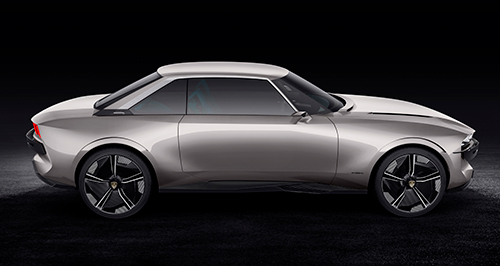Design & Tech: Peugeot e-Legend harks back

IT IS not an exaggeration to suggest that the French have wheeled out some of the most iconic automotive designs of the last century.
Renault, Citroen and Peugeot have all produced some stunning and memorable cars, particularly during the 1960s and 70s.
One model that can safely be described as iconic is Peugeot’s hugely successful 504. To this day you can see examples – usually the sedan – still getting around.
The 504 lasted just one very long generation from 1968 to 1983 – with a number of model year updates – and was produced everywhere from France to Argentina, Taiwan to Kenya. It was even assembled in Melbourne at one point.
Of the range, perhaps the most visually appealing variant was the two-door 504 coupe, penned by famed Italian car design house and coachbuilder, Pininfarina.
Now, Peugeot has quite literally gone back to the future with its achingly beautiful e-Legend concept.
Uncovered ahead of its Paris motor show debut, the e-Legend is a striking homage to the 504 coupe that clearly references the brand’s past, while pointing to its future.
To describe its design as retro is not doing the e-Legend justice. It is much more than that. It is, in fact, Peugeot’s take on the future of mobility.

Stray from the norm: While some manufacturers’ vision of the automotive future is a generic-looking autonomous box or pod, Peugeot has taken the opposite approach.
“Peugeot e-Legend concept is not just a technological manifesto,” Peugeot CEO Jean-Philippe Imparto said.
The company’s marketing department is pushing the point even further with the social media hashtag ‘#Unboring the future’.
Peugeot style director Gilles Vidal said the overall look is designed to get people thinking about the brand’s future, as well as appreciating its impressive past.
“A modern, sharper coupe, this ultra-technological archetype of automotive pleasure finds its deep strength in the DNA of the Peugeot 504 Coupe. Peugeot e-Legend concept projects us in the near future without any nostalgia.
“It formalises our approach to a Peugeot design that addresses the new technological challenges of the automotive industry.”
Peugeot says it’s choice of a stylish coupe for an autonomous vehicle “elevates” the drive experience, adding that the concept proves that a “hyper-technological vehicle can encompass the traits of a desirable vehicle”.
The emergence of electric platforms opens up the opportunities and possibilities for designers by losing the restrictions of a traditional internal combustion vehicle, according to Peugeot.
"From the front, the e-Legend is immediately recognisable as an homage to the Peugeot 504 coupe, down to the quad headlights and character lines on the downward sloping bonnet"
A traditional grille is not required for an EV, so in the case of the e-Legend, it hides sensors and other technical elements that control the driving aids.
The greenhouse is a flawless recreation of the 504 coupe, which is clearly evident in the C-pillars and the shape of the windscreen. The big wheelarches are also a nod to the original but the front arches gain an air passage, aiding airflow and aerodynamics.
Old and new Peugeot design elements combine at the rear with the three claw-like tail-lights a theme of recent Peugeots, including the 3008 SUV and upcoming 508 mid-size liftback, while the 504 coupe’s tail-lights were also split into three.
"Everything old is new again"
The exterior colour is a specific shade of grey with a hint of champagne and Peugeot says that depending on the light outside, the colour changes from a chrome reflection of the surrounding environment to a polished bronze metal.
This is apparently a similar process that is used for large perfume bottles. Who knew?
The e-Legend is 4650mm long, which is about the same length as a BMW 4-Series but it is 105mm wider, at 1930mm.
Inside, Peugeot designers focused on “warm materials”, which it says counterbalances the cold digital materials, which is a “contract to the frenzied race to all-digital”.
That slow southern style: In news that will be welcomed by some and derided by others, the interior is swathed in velvet.
The “H seat” design is a clear nod to the 504, but the rest of the cabin is modern digital, without overloading the senses with tech gadgets.
There are 16 screens of varying sizes in the cabin, digital materials, a digital toggle bar and other touches like a fragrant diffuser.
Powering the e-Legend is fully electric powertrain with 100kWh batteries pumping out a whopping 340kW and 800Nm, and driving all four wheels.
It has a 600km driving range and can hit 100km/h in less than four seconds and has a top speed of 220km/h.
Whether the e-Legend will ever become a production reality remains to be seen. But if it does, Peugeot will be one of the few brands to stand out from the increasingly generic crowd.
Want more design news? Click here to download your free copy of Design & Tech magazine